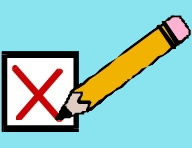
Leaflets
Election Leaflets are produced to enable you to enhance the profile of your candidate to people who may not know them and may never meet them. There are also a way to publicise you policies and campaign issues. If you are standing as a candidate almost by definition you have been motivated to that by something. It may be a desire to protect or improve local amenities, a desire to remove the incumbents for some reason or something else. Whatever it is no-one will know unless you tell them so put it in your leaflets, e.g. new zebra crossing, save local hospital from closure, money funds for old age donkeys, whatever it is that’s motivating you to stand tell people.
Give your leaflets a name. The Conservatives call theirs ‘In Touch’ the Liberal Democrats ‘Focus’ The Labour Party's vary in different parts of the country. This builds a brand even though voters may not see one from one election to the next.
Use graphics, photos and graphs if relevant. These fill space and are more likely to be looked at by voters than many paragraphs of closely typed copy no matter how fascinating you think it is. Leaflets are mostly printed as double sided A4 sheets. Deliver leaflets across the area you are working to every voter household. Use only recycled paper.
As to the content and layout of your leaflets that can vary, but I suggest you have a look at the examples on The Straight Choice for layout designs. should it return. However, because The Straight Choice specialises in highlighting controversial negative leaflets I would recommend that you do not use the type of content in the leaflets you are likely to find there.
For content I would say it is usual preferable to stick to positive upbeat stories about your candidate, what they have been doing and what they would like to do if elected. Negative stories are usually those that discuss the record or alleged actions of your opponents. Unless you have absolute categorical proof that your opponent has been involved in some kind of wrong doing do not use this kind of story. It makes you look like just another mudslinger, it negates any claim you have to be 'new' or different' and perversely advertises that your opponent is standing. If your opponents want publicity let them pay for it.
Here are some examples of leaflets and fliers from The Independent Network (all Powerpoint .ppt format)
Posters:
The Only Alternative Vote (insert candidate's name): http://bit.ly/eY9Eza
The Only Alternative Vote Independent: http://bit.ly/gJuLI5
Great Minds Think Independently: http://bit.ly/fCbHQeFliers:
Vote Independent: http://bit.ly/fYBJFb
Vote Independent (blank back for your candidate's information): http://bit.ly/eEu8FNWarning : I hadn't come across this issue before but do not place branded products of any kind on your leaflets or other election material unless you have the express and written permission of the owner of the trademark. I'm adding this on 22nd April 2010 and according to this BBC news report the BNP face a lawsuit for using the image of a jar of Marmite in a web election broadcast. Marmite is owned by Unilever who, like most companies, have customers who support all political parties and none. Companies do not associate themselves publicly with political parties because they do not want to alienate their customer base.
The BNP are saying that the Marmite was added in response to the current 'election' ad campaign run by Marmite feauting a Love party and a Hate party, but equally they are also saying they were not responsible for adding the image to the web broadcast and that it was added by one of the people to whom they had given the broadcast to review. So with a range of stories you can choose which to believe. Do not make this mistake as legal action can be expensive.
It is possible to buy Legal Cover Insurance for Election Campaigns but frankly in the run up to the vote you have not got the time to spend in meetings with lawyers so it best avoided.
Important: It is a commonly held belief that elections in the UK and contested by political parties. This is wrong. Although you must register your 'party' with the Electoral Commission, even if you are an Independent, elections in the UK are contested by candidates and agents and the candidate and the agent are responsible for everything that is done as part of the campaign. More significantly for leaflets everything published in support of the campaign must contain an imprint stating who printed and published the leaflet and their address. This usually takes form of a small print line at the foot of any leaflet saying "Printed by Anytown Printers, 30 High Street, Anytown, Anyshire and Promoted by John Smith, 25 Main Street, Anytown." or "Printed and Promoted by John Smith, of behalf of Jane Brown, 25 Main St Anytown.", where Jane Brown is the candidate and John Smith is the agent and the campaign headquarters or committee rooms is at 25 Main Street. This does not have to be John Smith's residence but it does have to be where the campaign can be contacted. Your imprint must appear on every leaflet, poster, calling card, press release or anything else you produce as part of the campaign. Failure to do so could put you in breach of the Representation of the People Acts and your opponents will soon let you know if it does.
Continue to Local Press....